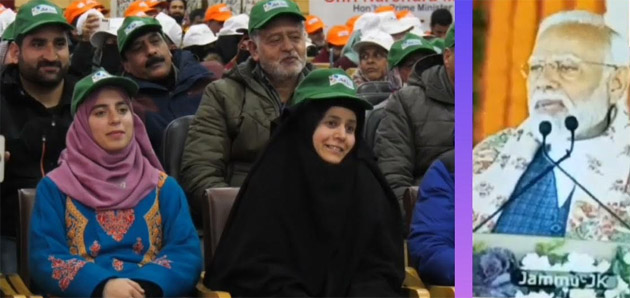Sanjay Kumar
The position of UT of Jammu and Kashmir is 17th in India in terms of Lakhpati Didi. The aim of Jammu and Kashmir for 2024-25 is more than 2.33 lakh and this will be accomplished with help of Self Help Groups (SHG). Out of these 86,727, 86,222 SHGs have attained complete status. 78,438 SHGs have already been assigned to Community Resource Persons (CRPs). According to the Lakhpati Didi monitoring report, when it comes to Jammu and Kashmir it has 70 lakh households out of which 63 Lakhs have been surveyed, which is the same as national level. But what is not the same is that UT has just 46856 households whose income is more than one Lakh per annum. These households just make up the 7% of total households of Jammu and Kashmir. Household annual income is used as a parameter for awarding a member title of Lakhpati Didi.
The term ‘Lakhpati Didi’ was first introduced by Narendra Modi, Prime Minister on the occasion of his speech on Independence day in 2023. This term was associated to encourage women to start micro enterprises for which they are trained in Self Help Groups (SHG), which comprises not more than twenty members created voluntarily for savings and credit without a collateral. Nirmala Sitharaman, Finance Minister of India during the 2024 budget session of Parliament also said that the Government has achieved a milestone of assisting one crore women becoming Lakhpati Didi. She announced that the goal for Lakhpati Didi has been raised to three crore in light of the success. Prime Minister Narendra Modi also expressed his desire to assist three crore women to become Lakhpati Didi during his recent visit to Jammu and Kashmir.
A member of a self-help group (SHGs) known as a “Lakhpati Didi” is someone who earns more than one lakh rupees annually, with an average monthly income of ten thousand rupees or more, sustained over the course of at least four business cycles and/or agricultural seasons. The self-help groups (SHGs) movement, is based on the principles of group solidarity and microfinance. In India, Self-Employed Women’s Association (SEWA) was established in 1972 by Ila Bhatt, which is considered the first Self-help group (SHG).
These SHGs are organised at the block, cluster, and village or gram panchayat levels. The institutions offer their members services such as credit, savings, and support for livelihoods that help them maintain and grow their means of subsistence. According to the Economic Survey 2022-23 Report, approximately 1.2 crore SHGs, or 88 per cent of all-women SHGs, serve 14.2 crore homes in India.
The “Deendayal Antyodaya Yojana-National Rural Livelihoods Mission (DAY-NRLM)” program of the Central Government acts as a catalyst by making financial support available and giving these women a place to flourish. A number of sub-schemes are being implemented under DAY-NRLM to improve the income of the rural poor on a sustainable basis such as the Mahila Kisan Sashaktikaran Pariyojana (MKSP), Start-up Village Entrepreneurship Programme (SVEP), National Rural Economic Transformation Project (NRETP), Deendayal Upadhyay Gramin Kaushalya Yojana (DDU-GKY), and Rural Self Employment Training Institutes (RSETI). State wise targets are set for different states which are then monitored to block level. According to Lakhpati Didi official website, Uttar Pradesh, West Bengal and Maharashtra have highest no. of targets numbering to 28.92, 28.40 and 17.42 respectively. According to the report, Jammu and Kashmir has 2,650 registered CRPs out of which 1,800 have already been assigned to SHGs. Jammu and Kashmir’s SHGs are distributed in 20 districts and among them Baramulla, Kupwara, Jammu, Anantnag and Budgam have highest no SHGs which are 8,758, 8,092, 7,160, 7,139 and 5,915 respectively whereas Srinagar has just 513 SHGs which is lowest in UT. Srinagar is followed by Shopian, Kishtwar, Ganderbal and Ramban which have 2004, 2352, 2566 and 2574 respectively. Kupwara has the most number of registered CRPs which are 355 in number followed by Budgam and Baramulla which have 275 and 232 CRPs respectively. Srinagar has least CRPs only numbering 38 which is followed by Reasi and Shopian with 53 and 55 CRPs respectively only.
Government report says that Srinagar district just has 21 households which have income above 1 lakh per annum which amounts to 1 percent of total households of the district. This is the least in UT. Another two districts are Kathua and Jammu which have 3 percent and 4 percent households respectively which have income above 1 lakh per annum. Whereas, Shopian has 20 percent of households which income above 1 lakh per annum. This is followed by Anantnag and Poonch with 16 percent and 12 percent households.
As on 31st January, 2024, India has a total of 84.85 Lakh with 9.2 crore members and about 9.98 crore Women households have been mobilised into 90.39 lakh Self Help Groups (SHGs). West Bengal has 10.85 Lakh SHGs which is highest in India, followed by Bihar and Andhra Pradesh with 1055169 and 853607 respectively. India has 9.2 Crore households out of which 8.2 crore have been surveyed which is 90 percent of the total. At national level there are just 1.4 crore (17 percent) households which have income of more than one lakh rupees per annum.
Therefore, the percentage of households with more income is much less in UT which presents a challenge as well as opportunities for the implementation of the Lakhpati Didi program. To implement and fulfil the program, the public must be aware about the program and the Government must take bigger initiative and footfall to inform the public about these initiatives. It is also essential to ensure convergence across all government departments, Panchayati institutions, private actors, and market players, the Ministry of Rural Development is implementing a whole-of-government approach.
(The author is a student of P.G. Diploma
in Digital Media, IIMC Jammu)


